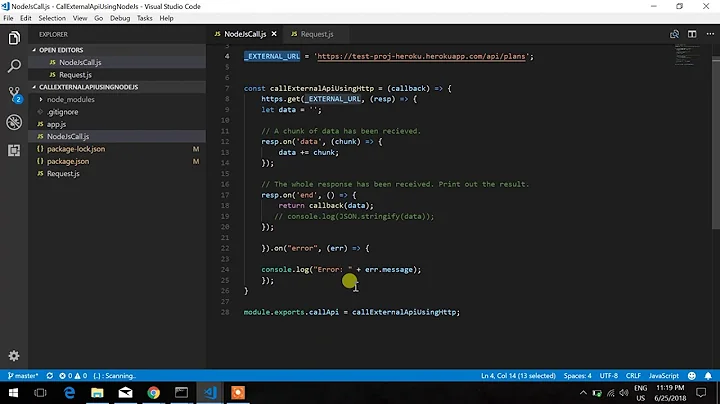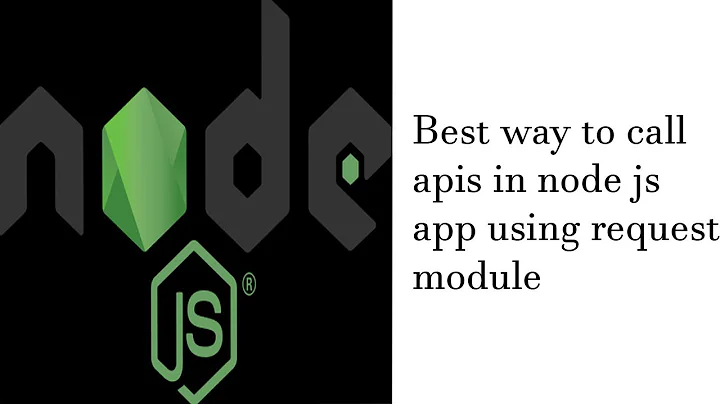How to make remote REST call inside Node.js? any CURL?
Solution 1
Look at http.request
var options = {
host: url,
port: 80,
path: '/resource?id=foo&bar=baz',
method: 'POST'
};
http.request(options, function(res) {
console.log('STATUS: ' + res.statusCode);
console.log('HEADERS: ' + JSON.stringify(res.headers));
res.setEncoding('utf8');
res.on('data', function (chunk) {
console.log('BODY: ' + chunk);
});
}).end();
Solution 2
How about using Request — Simplified HTTP client.
Edit February 2020: Request has been deprecated so you probably shouldn't use it any more.
Here's a GET:
var request = require('request');
request('http://www.google.com', function (error, response, body) {
if (!error && response.statusCode === 200) {
console.log(body) // Print the google web page.
}
})
OP also wanted a POST:
request.post('http://service.com/upload', {form:{key:'value'}})
Solution 3
I use node-fetch because it uses the familiar (if you are a web developer) fetch() API. fetch() is the new way to make arbitrary HTTP requests from the browser.
Yes I know this is a node js question, but don't we want to reduce the number of API's developers have to memorize and understand, and improve re-useability of our javascript code? Fetch is a standard so how about we converge on that?
The other nice thing about fetch() is that it returns a javascript Promise, so you can write async code like this:
let fetch = require('node-fetch');
fetch('http://localhost', {
method: 'POST',
headers: {'Content-Type': 'application/json'},
body: '{}'
}).then(response => {
return response.json();
}).catch(err => {console.log(err);});
Fetch superseeds XMLHTTPRequest. Here's some more info.
Solution 4
Look at http://isolasoftware.it/2012/05/28/call-rest-api-with-node-js/
var https = require('https');
/**
* HOW TO Make an HTTP Call - GET
*/
// options for GET
var optionsget = {
host : 'graph.facebook.com', // here only the domain name
// (no http/https !)
port : 443,
path : '/youscada', // the rest of the url with parameters if needed
method : 'GET' // do GET
};
console.info('Options prepared:');
console.info(optionsget);
console.info('Do the GET call');
// do the GET request
var reqGet = https.request(optionsget, function(res) {
console.log("statusCode: ", res.statusCode);
// uncomment it for header details
// console.log("headers: ", res.headers);
res.on('data', function(d) {
console.info('GET result:\n');
process.stdout.write(d);
console.info('\n\nCall completed');
});
});
reqGet.end();
reqGet.on('error', function(e) {
console.error(e);
});
/**
* HOW TO Make an HTTP Call - POST
*/
// do a POST request
// create the JSON object
jsonObject = JSON.stringify({
"message" : "The web of things is approaching, let do some tests to be ready!",
"name" : "Test message posted with node.js",
"caption" : "Some tests with node.js",
"link" : "http://www.youscada.com",
"description" : "this is a description",
"picture" : "http://youscada.com/wp-content/uploads/2012/05/logo2.png",
"actions" : [ {
"name" : "youSCADA",
"link" : "http://www.youscada.com"
} ]
});
// prepare the header
var postheaders = {
'Content-Type' : 'application/json',
'Content-Length' : Buffer.byteLength(jsonObject, 'utf8')
};
// the post options
var optionspost = {
host : 'graph.facebook.com',
port : 443,
path : '/youscada/feed?access_token=your_api_key',
method : 'POST',
headers : postheaders
};
console.info('Options prepared:');
console.info(optionspost);
console.info('Do the POST call');
// do the POST call
var reqPost = https.request(optionspost, function(res) {
console.log("statusCode: ", res.statusCode);
// uncomment it for header details
// console.log("headers: ", res.headers);
res.on('data', function(d) {
console.info('POST result:\n');
process.stdout.write(d);
console.info('\n\nPOST completed');
});
});
// write the json data
reqPost.write(jsonObject);
reqPost.end();
reqPost.on('error', function(e) {
console.error(e);
});
/**
* Get Message - GET
*/
// options for GET
var optionsgetmsg = {
host : 'graph.facebook.com', // here only the domain name
// (no http/https !)
port : 443,
path : '/youscada/feed?access_token=you_api_key', // the rest of the url with parameters if needed
method : 'GET' // do GET
};
console.info('Options prepared:');
console.info(optionsgetmsg);
console.info('Do the GET call');
// do the GET request
var reqGet = https.request(optionsgetmsg, function(res) {
console.log("statusCode: ", res.statusCode);
// uncomment it for header details
// console.log("headers: ", res.headers);
res.on('data', function(d) {
console.info('GET result after POST:\n');
process.stdout.write(d);
console.info('\n\nCall completed');
});
});
reqGet.end();
reqGet.on('error', function(e) {
console.error(e);
});
Solution 5
Axios
An example (axios_example.js) using Axios in Node.js:
const axios = require('axios');
const express = require('express');
const app = express();
const port = process.env.PORT || 5000;
app.get('/search', function(req, res) {
let query = req.query.queryStr;
let url = `https://your.service.org?query=${query}`;
axios({
method:'get',
url,
auth: {
username: 'the_username',
password: 'the_password'
}
})
.then(function (response) {
res.send(JSON.stringify(response.data));
})
.catch(function (error) {
console.log(error);
});
});
var server = app.listen(port);
Be sure in your project directory you do:
npm init
npm install express
npm install axios
node axios_example.js
You can then test the Node.js REST API using your browser at: http://localhost:5000/search?queryStr=xxxxxxxxx
Similarly you can do post, such as:
axios({
method: 'post',
url: 'https://your.service.org/user/12345',
data: {
firstName: 'Fred',
lastName: 'Flintstone'
}
});
SuperAgent
Similarly you can use SuperAgent.
superagent.get('https://your.service.org?query=xxxx')
.end((err, response) => {
if (err) { return console.log(err); }
res.send(JSON.stringify(response.body));
});
And if you want to do basic authentication:
superagent.get('https://your.service.org?query=xxxx')
.auth('the_username', 'the_password')
.end((err, response) => {
if (err) { return console.log(err); }
res.send(JSON.stringify(response.body));
});
Ref:
Related videos on Youtube
murvinlai
Updated on August 22, 2021Comments
-
murvinlai over 2 years
In Node.js, other than using child process to make CURL call, is there a way to make CURL call to remote server REST API and get the return data?
I also need to set up the request header to the remote REST call, and also query string as well in GET (or POST).
I find this one: http://blog.nodejitsu.com/jsdom-jquery-in-5-lines-on-nodejs
but it doesn't show any way to POST query string.
-
 Jonatas Walker over 7 yearsI wrote this github.com/jonataswalker/vps-rest-client
Jonatas Walker over 7 yearsI wrote this github.com/jonataswalker/vps-rest-client
-
-
murvinlai about 13 yearsSo, even it is POST, I also append data in the query string?
-
Raynos about 13 years@murvinlai not sure. Go read the docs, source, HTTP spec. Not an expert on that region.
-
weisjohn almost 12 yearsVersion 6.18 docs : nodejs.org/docs/v0.6.18/api/…
-
peter about 11 yearsHow do i access the values from d??? d = {"data":[{"id":1111,"name":"peter"}]} . how to get name value?
-
peter about 11 yearsmanaged to get values by using var thed = JSON.parse(d); console.log("the id is : "+thed.data[0].id); But some time i get "Unexpected end of input"
-
binarygiant about 11 yearsOne thing to note is that you don't put http or https in your host entry e.g. var options = { host: graph.facebook.com .... } not {host: http: graph.facebook.com }. That tripped me up for a few cycles. (See below). These are both great answers. Thanks to you both.
-
 Xerri about 11 yearsCan I just point out that if the reply is long, using res.on('data',..) is not enough. I believe the correct way is to also have res.on('end'..) to know when you have received all the data. Then you can process.
Xerri about 11 yearsCan I just point out that if the reply is long, using res.on('data',..) is not enough. I believe the correct way is to also have res.on('end'..) to know when you have received all the data. Then you can process. -
Rama over 7 yearsThis is a very old answer - for those writing node js today you'd surely use npmjs.com/package/node-fetch or other fetch API based package, which is based on the Fetch standard. See my answer below.
-
Dynamic Remo almost 7 yearsWorks fine with google.com but returning "RequestError: Error: socket hang up" when requesting facebook's graph api. Please guide, thanks!
-
user3072843 over 6 yearsCould you mention how you called the http module? require('WHAT?')
-
Pratik Singhal over 6 yearsThis module contains a lot of issues!
-
CodeMad over 6 years@user3072843, it's there in the link mentioned. require('node-fetch');
-
 vdenotaris about 6 yearsHow can I pass a request parameter while consuming a REST API in this way?
vdenotaris about 6 yearsHow can I pass a request parameter while consuming a REST API in this way? -
Sebastian over 5 yearsproblem with
node-fetchwhen writting APIs is that only works will full URL and will not work with relative URLs. -
 Sadiel about 4 yearsAs of Feb 11th 2020, request is fully DEPRECATED. You can see it in the website github.com/request/request#deprecated
Sadiel about 4 yearsAs of Feb 11th 2020, request is fully DEPRECATED. You can see it in the website github.com/request/request#deprecated -
 Steve3p0 about 4 yearsAny guidance on what newbies should use? I am filtering thru a LOT of examples that use this.
Steve3p0 about 4 yearsAny guidance on what newbies should use? I am filtering thru a LOT of examples that use this. -
 Steve3p0 about 4 yearsThis provides some guidance: github.com/request/request/issues/3143
Steve3p0 about 4 yearsThis provides some guidance: github.com/request/request/issues/3143 -
Rama about 2 yearsNote: fetch() is coming to the core NodeJS runtime as of v17.5 fusebit.io/blog/node-fetch








